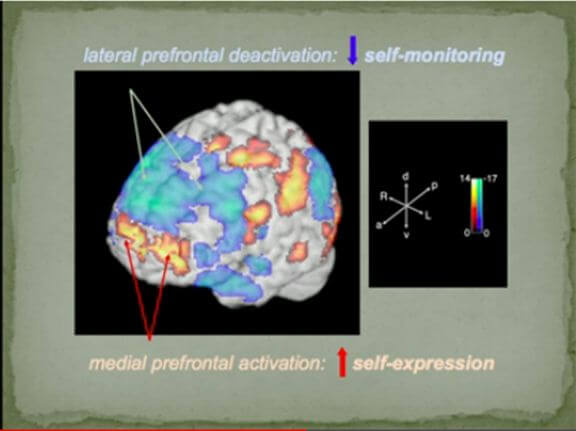In a TED talk surgeon Charles Limb described how he used an fMRI scanner to test which areas of the brain ‘lit-up’ when Rappers and Jazz musicians improvised musical passages (being creative) vs. Just remembering a musical sequence. Interestingly, he found that in creative mode these musicians’ medial prefrontal cortex (self-expression) was activated and their lateral prefrontal cortex (self-monitoring) deactivated.
This means that to enable creativity, musicians needed to be willing to make mistakes and not shut themselves off from ‘generative impulses’. In short, their self-monitoring need to be turned off and self-expression ‘turned on’.
“To be creative you have to have this weird dissociation in your frontal lobe, one area turns on and a big area shuts off so that you are not inhibited, so you’re willing to make mistakes, and you’re not constantly shutting down these new generative impulses” (Charles Limb, TED lecture)
What has this got to do with the firm?
Well, any organisation creates systems that have an impact on how employees behave and what parts of the brain are used and developed in work. So, if innovation is important, then the organisation has to create an environment that is consistent with generating ‘creativity’, hence from fMRI evidence avoiding situations where the brain is encouraged to act in a self-monitoring way and employees self-expression crushed.
Unfortunately, of course, what you do see in many businesses is the exact opposite. After an initial period of creativity, firms become weighed down by their own systems, measurements and management as they pursue with ever more intensity the avoidance of risk (and creativity is always a risk). Ultimately, administration begets administration and you can hardly move without an ROI.
The evidence shows that in creating such excessive self-monitoring, organisations are creating mental reactions in their employees that can only lead to significantly less innovation (the loss of which, of course, you don’t and can’t measure!).
Hence, processes designed to manage risk actually pose the biggest risk of all as they are inconsistent with the mental processes behind innovation.
Of course, no-one is saying let’s have a free for all, but there is a risk that in the general obsession towards bean-counting and over measurement firms miss the bigger picture that it’s not self-monitoring that drives growth but what you do, how you innovate.
In Customer Experience language there is a surfeit of analytical at the expense of creative equity in the firm.
This applies equally to who is recruited and promoted. One of the outcomes of a 1990’s investigation by British Chemical Company ICI (now part of Akzo Nobel) found that the most significantly qualified of its research chemists had contributed to the least number of patents. The fewer the scientific qualifications staff possessed, the greater the number of patents they had contributed to. The person who had contributed to most ICI’s patents had no scientific qualifications at all
Management Implications
- Don’t allow self-monitoring systems to get in the way of innovation.
- Create space for trial and error.
- fMRI evidence is the ultimate cause and effect, share the evidence and consider what your firms fMRI would be i.e., the balance between creative and analytical equity.
- Be cautious in your recruitment; look for evidence of creative potential.
| Steven Walden is VP Consulting and Thought-Leadership for Beyond Philosophy. Steven has 17 years Strategy Consultancy experience directing and designing strategies for major B2C & B2B firms. At Beyond Philosophy, the Global Customer Experience Consultancy, he is a Thought Leader and Innovator, directing engagements to assist leading firms to transform through Customer Experience. A world-leader in emotional experience his skills lie in innovation, thought-leadership, strategy consultancy and Qual/ Quant research. He is a regular speaker at conferences, blog writer, CE Trainer and international author. |



